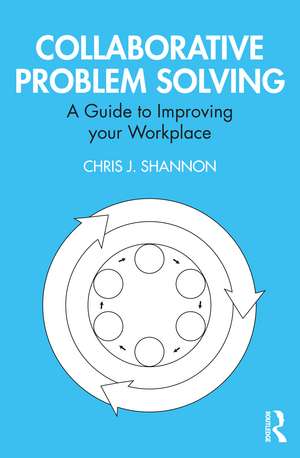Collaborative Problem Solving: A Guide to Improving your Workplace
Autor Chris J. Shannonen Limba Engleză Paperback – 23 iun 2021
Illustrated with a series of short case studies, this book provides an integrated approach to problem solving in the workplace. Collaborative Problem Solving walks through the steps in the problem solving process, introducing dozens of tools, techniques, and concepts to use throughout. Chris J. Shannon describes the behaviours to practice which are most conducive to creating a positive problem solving culture based on curiosity, collaboration, and evidence-based thinking. This book explains why successful problem solving is a collaborative process and provides tools and techniques for responding to other people’s behaviour when designing and implementing solutions.
Offering practical advice on problem solving in an easy-to-understand way, this book is aimed at people working in office environments, service industries, and knowledge organisations, enabling them to feel confident in applying the knowledge from the book in their own workplace.
| Toate formatele și edițiile | Preț | Express |
|---|---|---|
| Paperback (1) | 315.05 lei 43-57 zile | |
| Taylor & Francis – 23 iun 2021 | 315.05 lei 43-57 zile | |
| Hardback (1) | 997.11 lei 43-57 zile | |
| Taylor & Francis – 23 iun 2021 | 997.11 lei 43-57 zile |
Preț: 315.05 lei
Nou
Puncte Express: 473
Preț estimativ în valută:
60.30€ • 65.53$ • 50.69£
60.30€ • 65.53$ • 50.69£
Carte tipărită la comandă
Livrare economică 21 aprilie-05 mai
Preluare comenzi: 021 569.72.76
Specificații
ISBN-13: 9780367557584
ISBN-10: 0367557584
Pagini: 170
Ilustrații: 62
Dimensiuni: 152 x 229 x 13 mm
Greutate: 0.25 kg
Ediția:1
Editura: Taylor & Francis
Colecția Routledge
Locul publicării:Oxford, United Kingdom
ISBN-10: 0367557584
Pagini: 170
Ilustrații: 62
Dimensiuni: 152 x 229 x 13 mm
Greutate: 0.25 kg
Ediția:1
Editura: Taylor & Francis
Colecția Routledge
Locul publicării:Oxford, United Kingdom
Public țintă
Professional and Professional Practice & DevelopmentCuprins
Acknowledgements; Introduction; I.1 Problems and opportunities; I.2 Do what you can from where you are; I.3 Solving and sharing; I.4 How to use this book; Chapter 1 The Problem Solving Model; 1.1 Problem solving overview; 1.1.1 Similar features; 1.2 Steps in the problem solving process; 1.3 Problem solving behaviours; 1.4 Problem solving tools; 1.5 Creating shared understanding; Chapter 2 Problem Solving Behaviour; 2.1 Curiosity; 2.1.1 Curiosity through sharing; 2.2 Collaboration; 2.3 Evidence-based thinking; 2.3.1 Current state data; 2.3.2 Future state data; 2.4 Leadership and problem solving; 2.5 Contemporary Leadership Theories; 2.5.1 Transformational leadership; 2.5.2 Exemplary leadership; 2.5.3 Servant leadership; 2.5.4 Lean leadership; Chapter 3 Perceiving the Problem; 3.1 Is there actually a problem to solve?; 3.2 AIR 1 (Assessing Initial Readiness); 3.3 FOG (Fact, Opinion, Guess); 3.4 Five whys; 3.5 User stories; 3.6 Purposeful conversations; 3.6.1 Standing up for desks; 3.7 Consensus building; Chapter 4 Defining the Problem; 4.1 What is the problem we are trying to solve?; 4.2 High level process map; 4.2.1 Networked business; 4.3 Scoping document; 4.4 In frame / out of frame; 4.5 Problem solving teams; 4.5.1 The iceberg of ignorance; 4.5.2 Ordering new bins; 4.6 Fishbone diagram; 4.7 A3 problem statement; 4.8 AIR 2 (Alignment, Impact Readiness); 4.9 Measures to consider; 4.9.1 Is checking necessary?; 4.9.2 Error reduction measures; 4.9.3 Behavioural or cultural change; Chapter 5 Investigating the Problem; 5.1 Do we fully understand the problem?; 5.2 Understanding a process; 5.3 Swim lane process map; 5.4 Value vs non-value adding steps; 5.4.1 The welcome back event; 5.5 Rapid improvement event; 5.5.1 Virtual RIE in Tasmania; 5.6 Case study: Improving the onboarding process (Part 1); 5.7 Four voices; 5.8 Eight wastes; 5.9 RRS (runners, repeaters, strangers); 5.10 Theory of constraints; 5.11 Case study: Improving the onboarding process (Part 2); 5.12 Case study: The new payroll system; 5.12.1 Fishbone diagram; 5.12.2 Pareto analysis; 5.12.3 A3 problem statement; 5.13 Stakeholder analysis; 5.14 Spaghetti diagram ; Chapter 6 Selecting the Solution; 6.1 Are we confident we have picked the best solution?; 6.2 Ease/benefit analysis; 6.2.1 Determining ease; 6.2.2 Determining benefit; 6.3 Designing out errors (Poka yoke); 6.3.1 Cars and phones; 6.4 Repeatable and Reproducible; 6.5 Reducing cost vs creating capacity; 6.5.1 Discretionary effort; 6.6 SMART Goals; 6.7 Interim solutions vs future state solutions; Chapter 7 Implementing the Solution; 7.1 Are we ready to solve the problem?; 7.2 Implementation action list; 7.3 RACI chart; 7.4 Visual management; 7.5 Seeing new behaviour emerge; 7.6 Automation makes problems visible; 7.6.1 The visibility paradox; 7.6.2 Helping the customer accept and adopt; 7.6.3 Desire paths; Chapter 8 Reviewing the Results; 8.1 Have we solved the problem?; 8.2 Reviewing performance; 8.3 Track your capacity creation; 8.4 Customer journey maps; 8.5 STAR story telling; 8.6 Visual displays; 8.7 Process heat maps; 8.8 Reflection on the problem solving process; Chapter 9 Responding to Other People’s Behaviour; 9.1 Types of conflict; 9.1.1 Intrapersonal conflict; 9.1.2 Interpersonal conflict; 9.1.3 Role conflict; 9.1.4 Intragroup conflict; 9.2 Hierarchy of needs; 9.3 Group dynamics; 9.4 Two factor theory; 9.5 Force field analysis; 9.6 Supporting purposeful conversations; 9.7 Interest Based Negotiation; 9.8 Practicing Responses; Conclusion; Index
Notă biografică
Chris J. Shannon has worked in a variety of financial management and general management roles for the past 25 years, and is currently a manager at The University of Queensland. He has a Bachelor of Business in human resource management, and a Master of Business in leadership. Shannon believes the role of a leader is to create the conditions in which people can thrive, and that organisational success is achieved through developing people. He has previously published a chapter in Global Lean for Higher Education: A Themed Anthology of Case Studies, Approaches and Tools (ed. Stephen Yorkstone). This is his first book.
Descriere
Drawing on knowledge from process improvement, organization theory, human resource management, change management, occupational health and safety and other fields, the book is a practical, easy-to-read guide to problem solving.
